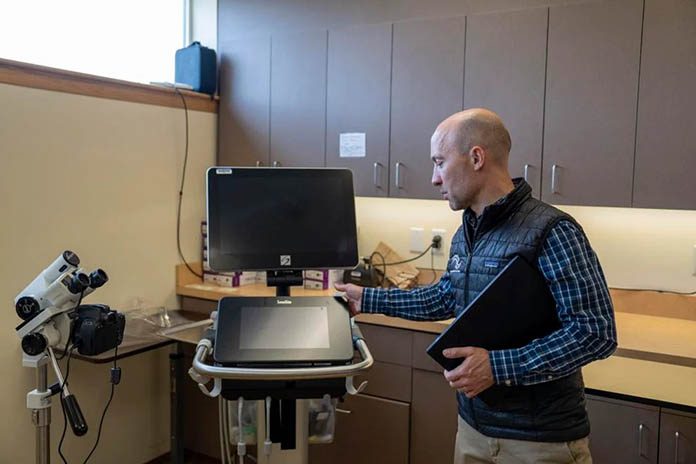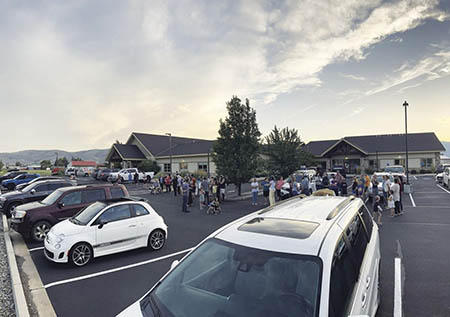
Baker City’s Saint Alphonsus Medical Center closed its birth center in late August 2023, a decision that received pushback locally, statewide and nationally.
Saint Alphonsus Health System, which owns and operates the hospital, shut down the center due to a decline in local deliveries plus a lack of obstetrics staff to meet needs. The closure helps highlight the challenges many rural Oregonians face in getting consistent, quality access to health care, but there are people working to eliminate the barriers.
Proposed legislation to help address needs
As chairman and ranking member of the U.S. Senate Committee on Finance, Sens. Ron Wyden, D-Oregon, and Mike Crapo, R-Idaho, held a hearing May 16 on rural health care.
“I wanted to hold the hearing because quality and accessible rural health care is an essential part of rural life in Eastern Oregon and in other rural communities around the state,” Wyden said via email. “And yet the challenges to that quality and accessible care are growing both in frequency and magnitude. My goal was to come out of that hearing with real and achievable solutions that can be applied in Oregon and nationwide.”
Members of the finance committee heard testimony from four witnesses who spoke to the challenges of providing health care in rural areas as well as offered ideas on specific solutions to meet the needs of rural residents.
Wyden said he had three main takeaways from the hearing.
“As evidenced by what happened with the loss last year of local maternity services in Baker, rural communities face a continuous and unacceptable threat of losing OB-GYN care,” he said. “Telehealth has a big part to play in delivery of health care to rural communities. And it’s becoming harder and harder to match rural communities’ health care workforce needs with their health care demands.”
The hearing precipitated Wyden’s June 17 announcement, alongside 15 other Senate Democrats, of the Keeping Obstetrics Local Act draft legislation. KOLA would increase Medicaid reimbursements for hospitals in rural areas as well as help with covering the cost losses associated with staffing and running an obstetrics unit in rural community hospitals with relatively few births.
“This legislation will give rural and underserved hospitals the means to keep their labor and delivery units open and ensures that large hospital chains will not take the money and run,” Wyden said in a press release.
The proposal has received support from associations and hospital leaders in Oregon, which has seen obstetrics units closing despite objections from local community members. Many of the same reasons that maternal care units are closing, such as high costs, staffing challenges and low federal reimbursement, are examples of the challenges that the state’s rural health care faces more broadly.
Challenges to access abound
Robert Duehmig, director of the Oregon Health & Science University Office of Rural Health, said he heard from residents across Eastern Oregon on a recent listening tour that social factors such as housing and transportation immensely affect the accessibility of health care.
Rural communities tend to have less public transportation than urban areas, which makes it difficult for those without vehicles to get to care facilities.
Additionally, housing costs are high almost everywhere, Duehmig said. But in rural areas, especially, affordable housing is particularly challenging to find.

Maternal care in particular is increasingly hard to access in rural areas, with about 25% of rural hospitals nationwide having eliminated obstetrics units between 2011 and 2021, according to a February 2024 report from health care consulting firm Chartis.
And getting more specialty care, such as for cancer or rare diseases, may require hours of travel or even going out of state.
Additionally, rural areas tend to have higher poverty rates than their urban counterparts, and a larger proportion of the population has Medicare or Medicaid — through the Oregon Health Plan — as its health insurance provider.
While this insurance should make it easier to access care on a broad level, serving more Medicare and Medicaid patients equates to lower profits for hospitals or clinics due to the plans’ reimbursement scales. This, in turn, can make it less appealing for providers to live and serve in rural areas because there are often lower compensation packages due to lower patient volumes plus the higher proportion of patients in poverty.
Rural doctors as general specialists
Nic Powers, CEO of Winding Waters Health Center, a nonprofit, federally qualified health center in Wallowa County, said part of ensuring access to care requires rural health care providers to work at the “tops of their licenses,” meaning they do almost everything their license allows them to do.
In more urban settings, even general providers can become more specialized, but that doesn’t work in smaller communities with fewer providers and specialties. Powers said primary care doctors in Enterprise are probably less likely to refer someone to a specialist unless they’ve exhausted their own experience and consulted with doctors elsewhere, especially because they know referrals can be prohibitively hard for people to access from rural areas.
“For example, I hear our docs calling the OHSU consult line, asking for, you know, detailed advice so they can take care of a patient here instead of making them travel for that specialty care,” he said. “They don’t want to have to make a patient go hundreds of miles for that specialty care if we can get some information and help from here.”
Providers across health care areas also integrate their care at Winding Waters. Dentists, family medicine providers and social workers all communicate about patients if they notice the patient isn’t getting the care they need in one part of their life.
Mary Goldstein, a licensed clinical social worker with the clinic, said June 18 she’d had a warm handoff with a doctor just that morning. The doctor was seeing a patient she believed would benefit from counseling and asked Goldstein to come meet him. Once he’d met her, it was easier for him to agree to come in for a session or two.
That’s what it means to have an effective “no wrong door” policy, Goldstein said, which allows the clinic to provide better holistic care.
“He came in for a different physical health issue, but before he walked out, he had an appointment with me and had met me,” she said. “So he didn’t come in a mental health door, but he met a mental health provider.”
Technology helps but has hurdles
One of the most prominent aspects of medicine in recent years — especially since the pandemic — has been telehealth, providing another way for remote patients to access care more easily.
Many health care providers have been expanding to offer these services for a long time and are well aware of the benefits and pitfalls, including Grande Ronde Hospital in La Grande, which has offered telemedicine appointments since about 2007.
During the Senate finance committee hearing in May, Jeremy Davis, Grande Ronde’s president and CEO, testified about his hospital’s approach to telehealth and what its needs are.
“Telemedicine provides access to specialties not available locally by tapping into specialty expertise typically only available in larger cities,” he said.
Virtual appointments are sometimes easier for people to access if they have time constraints, mobility restrictions or difficulty with transportation. However, there are challenges that disincentivize its use in rural areas.
First, many rural areas, including Eastern Oregon, don’t have the internet infrastructure to support video conferencing at the necessary level. Without better broadband access in the region, telemedicine appointments will not be truly accessible for all patients.
“There’s a significant pay discrepancy between an in person visit versus a telehealth appointment,” Davis said. “I know early on in the pandemic, you probably could have heard a collective sigh of relief when we saw that we were going to be able to get paid the same for a telehealth visit as well as an in person visit.”
In rural areas, with higher proportions of patients relying on Medicare and Medicaid, and with high incentives associated with telehealth for patients — due to longer travel times or lack of public transportation, for example — this compounds and can hurt providers.
“To be able to leverage technology is huge, but there’s a misaligned incentive whereby these rural health clinics and (federally qualified health centers), we don’t get the equal payment,” Davis said. “And so it’s to our advantage for those who run these clinics to prioritize and prefer and almost push these patients to come in for a visit.”
Plus, Davis added, clinics and hospitals need to offer spaces for doctors to work from during telemedicine appointments, which can also create additional costs that tend to not get covered due, at least in part, to the lower reimbursement rates.
“To me, it shouldn’t matter whether we’re rendering that service via a camera or a microphone or whether in person,” he said. “We’re taking care of rural Americans and therefore the payment should be on par.”








